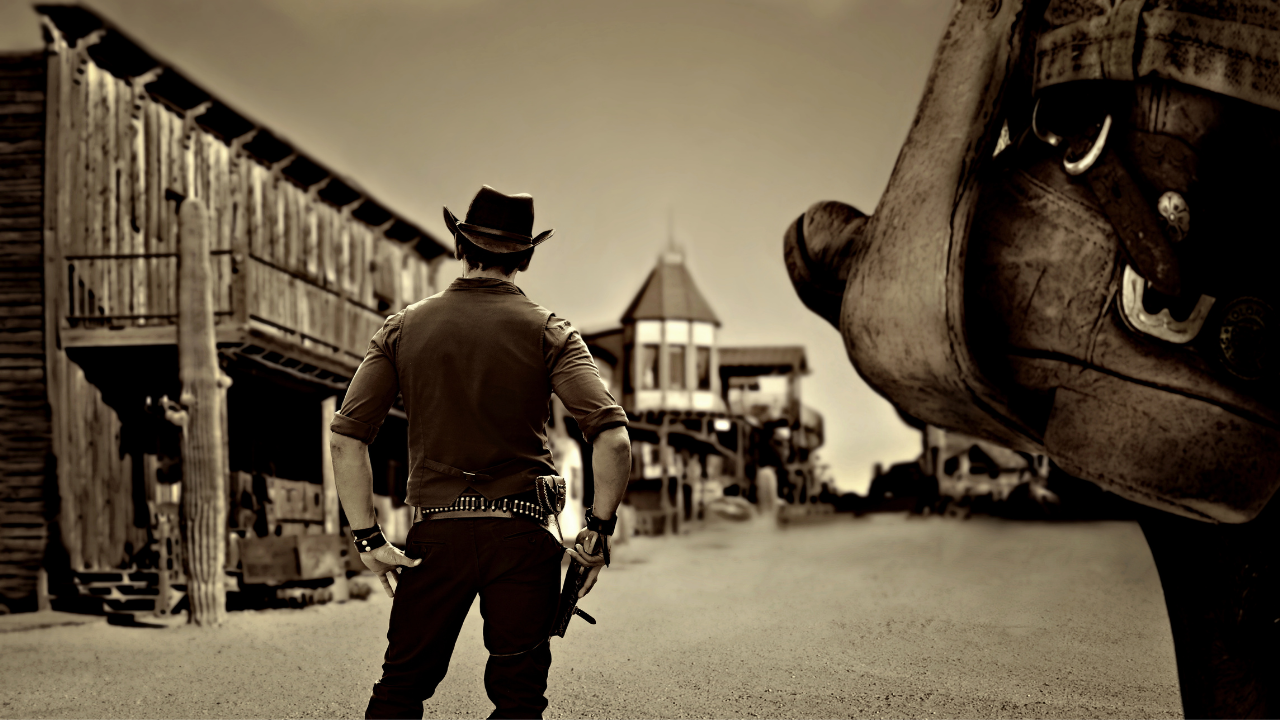path of the storyteller / blog
shootout at the corral

You know I love a good pithy saying. Here’s one I made up, just for you: Good books get read; great books get reread.
Think of the books on your shelves. Most of them you’ll read once, but the ones you absolutely love you will surely read again and again.
A great book is a friend for life. The better you know it, the more you love to reread it — and you can take that as proof that great storytelling does not depend on keeping secrets from the reader.
A common authorial misstep is to conceal the hero’s true mission from the reader.
Why do this? These authors mistakenly assume that secrecy equals suspense. They hope that the reader will keep reading in order to find out what’s really going on.
It’s a false hope, alas. The reader keeps reading to find out not what the climactic scene of the plot is, but how that scene turns out.
Will the Wizard help Dorothy get home to Kansas? Will Katniss survive the Hunger Games? Will Bilbo prevail when he finally comes face to face with the dr...
the practice of writing

“How do you get to Carnegie Hall?” It’s an old joke, and the punchline, of course, is “practice!”
“Head north on Broadway and make a right on 57th Street” is also a correct answer, but it limits itself to physical circumstances only. Such literal-minded directions might get you to the door of the building, but they won't make you a world-class player. Only many, many hours of tush-on-bench with guidance from a worthy instructor will achieve that outcome.
My ruminations yesterday about story energy are the fruits of a lifelong practice in the storytelling arts. A mix of study, mentorship, and a huge volume of hands-on doing has served me well. To incline toward action is advice worth its weight in gold; if you don’t write a lot, your writing will not improve.
If your writing is not all you wish it were, that’s all the more reason to produce more of it. Write, write, write! Write straw today so you can spin it into gold tomorrow. The only way out is through.
As to where to find tho...
facing the shadow

Yesterday’s talk of tricksters got me thinking about the archetypal energies that infuse every story. I call them energies because I consider storytelling a form of energy.
If that sounds a bit vague or metaphysical to you, consider this: A story is not its physical form. It is not the book between hardcovers; it is not the film on celluloid or digital data; it is not the little clickable box on your Netflix home page that takes you (at last!) to the new season of The Crown. Now you know what I’m doing this weekend!
Story is a non-physical phenomenon that connects both author-to-reader and reader-to-reader. It’s the deep engagement with fictional characters in a made-up world; the feeling of having taken a journey with those characters and being altered by the trip, just as we are affected by the events of our real lives.
Oral traditions may manifest in written versions that later get made into movies and graphic novels, but which one of them is the story? None of them, really. The...
whoops!

Sometimes my Path of the Storyteller students get that furrowed-brow look. They’re trying to invent, trying to write well, trying to get to the end of a draft, all the while knowing that many revisions will be in store before the book is “done.”
That’s when we talk about the need to be playful. We’re just making stuff up here, people! We writers have total power over what happens on our pages, and a boundless capacity to invent, toss, and invent again. If we do our jobs well, we will have created something that never existed before. A new story! What could be better? There ought to be much joy involved.
It’s a good writing practice, too. As your story picks up pace and builds in intensity, a few well-placed moments of levity are always welcome. This is where a bit of trickster energy might be just the banana peel you’re looking for.
The trickster is one of the common character archetypes that appear in stories throughout history and across cultures. (As ever, I’m indebted to the w...
now what?

Rollercoasters: Yes or no?
I have friends who love ’em, and friends who, like me, cannot be dragged near one. I was once tricked into going on Space Mountain by two people who should have known better. I still speak to them—well, one of them!
I’m more of a merry-go-round type of person, as long as they don’t spin too fast. The car-sickness struggle is real, but there’s consolation in the words of Gustave Flaubert, who once wrote to a friend that a settled, ordinary life is what makes it possible to be fierce and adventurous in one’s work.
Clearly, real life and fiction are two different things. Yet good art has a way of piercing through the fog of everyday perception and revealing profound emotional and psychological truth. Our lives are a search for meaning. Great storytelling gives us exactly that.
If you’re a noir-minded sort of person, you might argue that stories offer the false comfort that there is meaning in what is essentially chaos. You may even write stories that attem...
the exact middle

The Hobbit is one of my all time faves. (So is Jane Eyre, which I share as evidence that there’s no need to pigeonhole ourselves, as readers or writers.)
Tolkien’s masterpiece opens with a description of Bilbo Baggin’s home, which boasts a green door with a shiny yellow brass knob in the “exact middle.” The difference between “the middle” and “the exact middle” is everything you need to know about Bilbo Baggins. He is the Felix Unger of hobbits, and that one prissy detail foreshadows all the chaos, danger, and discomfort that is to come.
It’s what I call a detail that’s inflected with character. Inflected details are a subject for another post, but today I want to talk a bit more about middles, and not only middles — the middle of the middle. The exact middle.
In writer parlance, the midpoint.
Today is November 15th, and if you are NaNoWriMoing, you have reached the exact middle of the month. Whether you’ve reached the exact middle of your story I don’t know, but here’s what to th...
that voice

I played a rousing Zoom-hosted game of Ex Libris last night with some dear friends on the opposite coast. Do you know that game? It is so fun, so writerly, and really a fantastic exercise in voice.
I’ll tell you how to play in a minute, but first let me define what I mean by voice.
Voice is the metaphysics of style. The prose style you create for a book has a tone and personality all its own. It’s why a sentence of Jane Austen is distinguishable at a glance from a sentence of Tolkien. You’ll never answer the phone and think Salinger is talking when, in fact, it is Hemingway.
Word choice, sentence and paragraph rhythms, the kinds of details chosen, the way of seeing the world that is conveyed by what is said — all of these are part of voice. Together, they add up to a quality all great writing has: the unmistakable feeling that there is an actual, living personality on the other side of the page. That you, Dear Reader, are not alone. You are with someone as you read.
Hence my us...
tgif

Whew! Sometimes life just feels RELENTLESS, am I right?
It’s what so many are experiencing in 2020, a year that keeps trying to top itself in terms of plot twists. We’re all the heroes of our own life stories, and this year has been a long, long, LONG second act.
Each day, we choose how to respond. We face challenges we may never have imagined. We soul-search and find the bedrock our true values. We take action, care for and console one another, grieve, fight, lead, make sacrifices, and (perhaps hardest of all), extend a hand of peace.
We make tough choices daily, under escalating pressure. And guess what? It’s exhausting.
It’s not easy being a hero, even a fictional one. The hero of your story is going through tough stuff, page after page. Your reader is along for the ride, and frankly they’re both going to want a break now and then.
Within your fictional hero’s journey, there must be moments for your protagonist to rest and regroup. Bilbo and the dwarves paused for a helpful ...
good bones

You know the old joke about “boneless chicken,” right? How did it walk?
As a long-time vegetarian, I don’t worry much about bones in my cooking! But I think about them All. The. Time. in my writing.
Just as the overall story has a structure, so must each scene. This is especially true in the middle, or second act.
Why? The middle is most of your book. A long expanse without some sturdy support is not going to hold up. It’s a tent without a tentpole.
The middle’s job is to place obstacle after obstacle in the way of your hero’s progress toward her goal, or mission. Think of it as a series of tests. Some, your hero will pass; some she’ll fail; some she’ll barely scrape through.
Each test forces her to level up in some way (a story is a journey of change, as I’m sure you recall!). But a series of tests can too easily look like this: Test. Test. Test. Test. Test. Scene after scene after scene.
Monotonous, no? And that’s most of the book! So how does the middle not turn to repetitive,...
the rest of the gang

In yesterday’s writing tip, I talked about keeping your hero firmly in the driver’s seat of your story.
But what about all those other characters? If the hero makes the choices that move the story forward, what exactly is the secondary cast of characters doing?
I’ll tell you what they’re not doing. They’re not doing nothing. They’re not extras. In opera they’re called spear carriers — the human set dressing that fills those vast stages.
A story is a designed thing, a work of both art and artifice. Strunk and White remind us that, just like a well-designed machine, good writing ought to have no unnecessary parts — including characters.
Each secondary character must have a necessary job to do, and that job is to impact the journey of the hero. Positively or negatively, there is an impact. Your hero can’t get to the finish line of meaningful change without them.
I love the work of Joseph Campbell and use the idea of archetypes in my own work (it’s what I teach my writing students, ...


